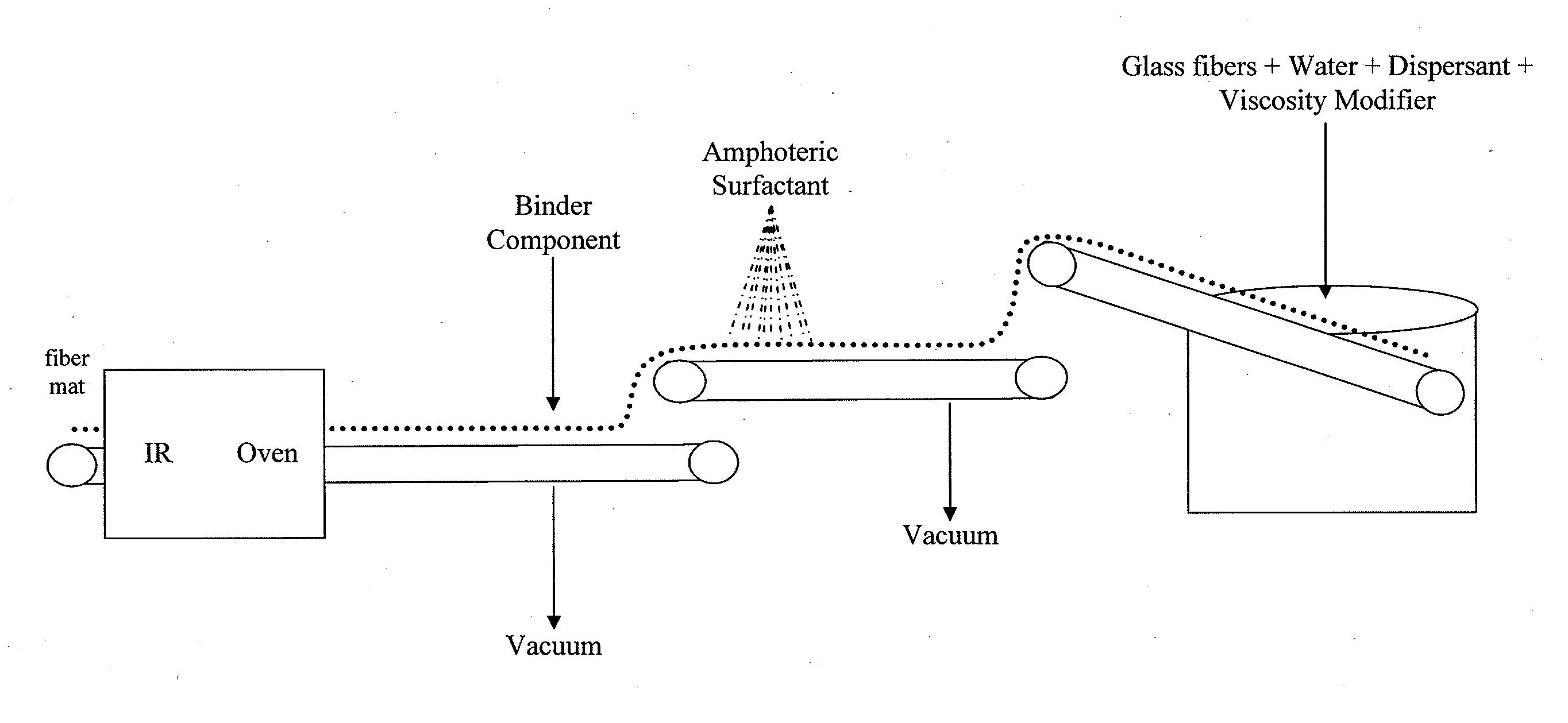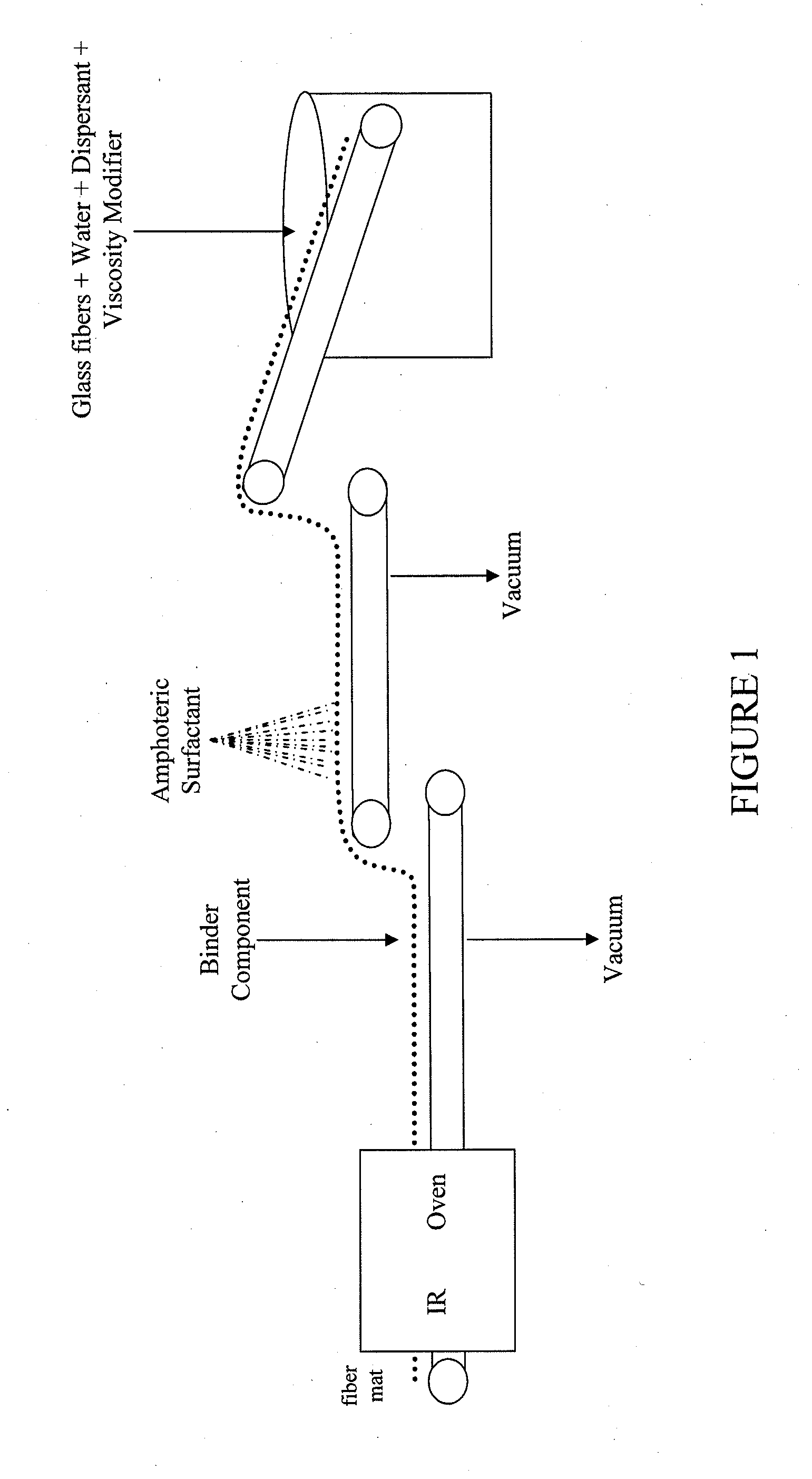Asphalt emulsions, products made from asphalt emulsions, and processes for making fibrous mats from asphalt emulsions
a technology of asphalt emulsion and asphalt emulsion, which is applied in the field of asphalt emulsion and products made from asphalt emulsion, can solve the problems of undesirable effects, high cost, and difficult production of asphalt-impregnated rag felt mats in large quantities, and achieves cost savings, improved tear resistance and tensile strength, and light weight
- Summary
- Abstract
- Description
- Claims
- Application Information
AI Technical Summary
Benefits of technology
Problems solved by technology
Method used
Image
Examples
example 1
[0061]Table I below provides the components of an asphalt emulsion made in accordance with one embodiment of the invention. Four parts, A, B, C and D, were prepared and then mixed together. After the four parts were mixed together, the mixture contained a total concentration of 72% of all the components. The mixture was then diluted with water to make a final emulsion having a final concentration of 30% of all the components. This final emulsion was applied as a binder to a wet-laid glass fiber web.
TABLE IComponentABCDPDA68%———HCl—1.0%——Redicote ® E-11—1.0%——CMC—0.5%——GA240——0.5%—UP 1935——0.5%—Diesel fuel———0.5%Total68%2.5% 1%0.5%Temperature330-350° F.75° F.75° F.75° F.
[0062]Table II provides data showing the physical properties of exemplary fibrous mats of the invention (test), which are made with the above embodiment of asphalt emulsion, as compared to control mats made with urea formaldehyde as the binder. Test coupon refers to exemplary fibrous mats of the invention coated with ...
example 2
[0064]Table III below provides the components of an asphalt emulsion made in accordance with another embodiment of the invention. Three parts, A, B and C, were prepared and then mixed together. After the three parts were mixed together, the mixture contained a total concentration of 100% of all the components. The mixture was then diluted with water to make a final emulsion having a final concentration of 30% of all the components. This final emulsion was applied as a binder to a wet-laid glass fiber web.
TABLE IIIComponentABCPDA30%——CMC—0.5%—GA240—0.5%—Urea formaldehyde——69%Total30% 1%69%Temperature330-350° F.75° F.75° F.
[0065]Table IV provides data showing the physical properties of exemplary fibrous mats of the invention (test), which are made with the above embodiment of asphalt emulsion, as compared to control mats made with 90% urea formaldehyde and 10% GL-618 acrylic (Rohm and Haas; Philadelphia, Pa.) as the binder. Test coupon refers to exemplary fibrous mats of the invention...
example 3
[0067]Table V below provides the components of an asphalt emulsion made in accordance with yet another embodiment of the invention. Five parts, A, B, C, D and E, were prepared and then mixed together. After the five parts were mixed together, the mixture contained a total concentration of 70% of all the components. The mixture was then diluted with water to make a final emulsion having a final concentration of 30% of all the components. This final emulsion was applied as a binder to a wet-laid glass fiber web.
TABLE VComponentABCDEPDA33.5% ————HCl———1.0%—Redicote ® E-110.5%——1.0%—Redicote ® AP0.5%————Redicote ® C-4500.5%————CMC——1.0%——GA240—1.0%———UP 1935———0.2Urea formaldehyde————30.8%Total 35% 1% 1%2.2%30.8%Temperature330-350° F.75° F.75° F.75° F.75° F.
[0068]Table VI below provides data showing the physical properties of an exemplary fibrous mat of the invention (test), which are made with the above embodiment of asphalt emulsion, as compared with control mats made with urea formal...
PUM
| Property | Measurement | Unit |
|---|---|---|
| temperature | aaaaa | aaaaa |
| temperature | aaaaa | aaaaa |
| temperature | aaaaa | aaaaa |
Abstract
Description
Claims
Application Information
 Login to View More
Login to View More - R&D
- Intellectual Property
- Life Sciences
- Materials
- Tech Scout
- Unparalleled Data Quality
- Higher Quality Content
- 60% Fewer Hallucinations
Browse by: Latest US Patents, China's latest patents, Technical Efficacy Thesaurus, Application Domain, Technology Topic, Popular Technical Reports.
© 2025 PatSnap. All rights reserved.Legal|Privacy policy|Modern Slavery Act Transparency Statement|Sitemap|About US| Contact US: help@patsnap.com


